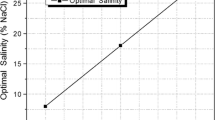ABSTRACT
The empirical hydrophile-liophile balance (HLB) value of nonionic surfactants is an important parameter used to predict performance as, e.g., emulsifiers, solubilizers and wetting agents. However, the HLB value is based on an original molecular structure and does not take into account all the factors affecting the performance of nonionics, such as presence of additives, type of solvent, temperature, degree of hydration, structural modifications of the surfactant molecule and decomposition of surfactants. On a performance basis, where these factors come into play, a given nonionic surfactant may exhibit a multiplicity of apparent HLB values. Accordingly, we recently introduced the term “effective HLB value” which is a performance value which incorporates into the HLB the parameters listed above. The HLB value thus becomes a variable depending on the physical and chemical conditions at the time of the measurement. In this work, we investigated the effect of adding glycols and diglycols on the HLB using 3 different methods: cloud point, phenol index and critical micelle concentration (cmc). We found that this type of additive increases the cloud point, phenol index, cmc and the “effective HLB” of a polyoxyethylated nonionic surfactant. The effectiveness of the glycols in causing these increases was in the following order; dipropylene glycol > 1,4-butanediol > 1,2-propanediol > diethylene glycol > ethylene glycol. The solvent effect of glycols and diglycols on the hydrophobic and hydrophilic portions of the surfactant molecule are discussed. On the hydrocarbon part of the surfactant molecule, the solvents cause a weakening of the hydrophobic bond and an increase in the cmc. On the polyoxyethylene part of the molecule, the solvent may cause either an increase or a decrease in the cmc. The effect on the hydro-philic portion is related to hydrogen bonding exhibited by the additives. The results obtained again suggest that the effective HLB value, which is a measure of the HLB under operative conditions, may be of greater practical significance than calculated HLB.
Similar content being viewed by others
REFERENCES
Marszall, L., and J.W. Van Valkenburg, Adv. Pesticide Sci. 3:789(1979).
Marszall, L., Tenside Deterg. 16:303 (1979).
Maiszall, L., Fette Seifen Anstrichm. 80:289 (1978).
Shinoda, K., J. Colloid Interface ScL 24:4 (1967).
Shinoda, K., Proc. 5th Intern. Congr. Surface Act. Substances, Barcelona 2:275 (1968).
Lin, I.J., and L. Marszall, Tenside Deterg, 14:131 (1977).
Marszall, L., Cosmet. Toiletries 93:53 (1978).
Becher, P., in “Nonionic Surfactants,” edited by M.J. Schick, Marcel Dekker, Inc., New York, NY, 1967, p. 1478.
Schott, H., J. Pharm. Sci. 58:1443 (1969).
Maiszall, L., J. Colloid Interface Sci. 65:589 (1978).
Becher, P., J. Colloid Sci. 20:728 (1965).
McDonald, C, J. Pharm. Pharmacol. 22:148 (1970).
Nishikido N., Y. Moroi, H. Uehara and R. Matuura, Bull. Chem. Soc. Japan. 47:2634 (1974).
Gratzer W.B., and G.H. Beaven, J. Phys. Chem. 73:2270 (1969).
Becher, P., and S.E. Trifeletri, J. Colloid Interface Sci. 43:485 (1973).
McNicoll, B., J. Sangster and H.P. Schreiber, in “Solution Chemistry of Surfactants,” edited by K.L. Mittal, Plenum Publishing Co., 1979, p. 367.
Magid, L., Ibid. p. 427.
Rigamonti, R., and M.T. Cereti Mazza, Riv. Ital Sost. Grasse 47:532(1970).
Daguchi, K., T. Mizuno and K. Meguro, J. Colloid Interface Sci. 48:474 (1974).
Ray, A., and G. Nemethy, J. Phys. Chem. 75:809 (1971).
Vogt, H., and R. Dillmann, Pharm. Ind. 28:146 (1966).
Marszall, L., Fette Seifen Anstrichm. 82:40 (1980).
Crook, E.H., D.B. Fordyce and Y.F. Trebbi, J. Phys. Chem. 67:1987(1963).
Kucharski, S., Surface Active Alkjdene Oxide Adducts; Structure and Properties, Wyd. Polit. Wroclaw, Wroclaw, 1978, pp. 88.
Shinoda, K., and H. Takeda,- J. Colloid Interface Sci. 32:642 (1970).
Florence, A.T., F. Madsen and F. Puisieux, J. Pharm. Pharmacol. 27:385 (1975).
Arai, H., J. Colloid Interace Sci. 23:348 (1967).
Marszall, L., and J.W. Van Valkenburg, Ind. Eng. Chem. Prod. Res. Dev. (in press).
Kato, Y., Chem. Pharm. Bull 10:771 (1962).
Lindman, B., and H. Wennerstrom, Top. Curr. Chem. 87:1 (1980).
Fowkes, F.M., “Solvent Properties of Surfactant Solutions,” edited by K. Shinoda, Marcel Dekker, New York, NY, 1967, p. 69.
Pearson, R.G., Science 151:172 (1966).
Barton, A.F.M., Chem. Rev. 75:731 (1975).
Author information
Authors and Affiliations
About this article
Cite this article
Marszall, L., Van Valkenburg, J.W. The effect of glycols on the hydrophile-lipophile balance and the micelle formation of nonionic surfactants. J Am Oil Chem Soc 59, 84–87 (1982). https://doi.org/10.1007/BF02678718
Issue Date:
DOI: https://doi.org/10.1007/BF02678718




